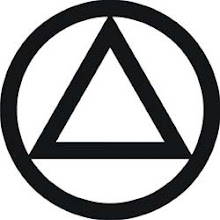For those who own a 3rd Edition Big Book printed after 1993, or any printing of the 4th Edition, you won't find this very important symbol on your Title Page. However, most of us who have been around AA are familiar with the Circle and Triangle. You'll find it on the face of sobriety chips, the front doors of Alano Clubs, necklaces, rings, and even tattoos. We know that this is the symbol of our Fellowship, but what exactly does it mean?
The equilateral triangle represents the three part solution – recovery, unity, and service - to our three part disease - physical, mental and spiritual, while the circle represents wholeness or oneness.


Adopted in 1955 at the 20th Anniversary International Convention in St. Louis, the symbol was discontinued by AA as their official logo in 1993. Lawyers had advised the AA General Service Board that the copyright on the logo was unenforceable. So, because AA did not want to go into the business of producing sobriety chips - clearly an outside issue, and because going into litigation over the symbol would most likely prove to be a futile, or even harmful, AA officially gave up their logo.
For the sake over brevity, I won’t go into further detail. However, you may read further on the issue here.
AA has not banned the use of the circle and triangle. It has merely stopped using the symbol on official AA materials. Our books and pamphlets now contain the phrase, “This is A.A. General Service Conference-approved literature."
I’m not going to take a side on the issue. What’s done is done, and there is nothing I can do to change AA General Service Board’s efforts to keep, or decision to discontinue the symbol. However, it is very important to remember that the circle and triangle represent something that we don’t seem to want to discuss much in our meetings, the entirety of the program. In fact, when I sit down with sponsees for the first time, I ask them to draw the symbol on the Title page of their books. It is so much more than a recognizable logo (like the McDonald’s golden arches or the Nike swoosh). It can help us take inventory of the quality of our own programs, and the programs of those that we sponsor.
So, we can use the three sides of the triangle as a sort of checklist. I open up my book and ask myself some questions about the three legacies and what they represent in my own recovery:
Recovery (bottom): Have I worked all 12 steps? Am I current with my first step experience? Do I have any unfinished amends? Where am I at with the disciplines of steps 10 and 11? When was the last time I went back through steps 1 through 9.
Unity (left): Am I attending meetings? Am I loyal to my home group? Am I involved with other members of AA outside of meetings? Do I understand the common problem and common solution (See Page 17)?
Service (right): How many people am I sponsoring? Where are those sponsees in the steps? If need be, am I prepared and available to go on a 12th step call? Am I chairing meetings, greeting folks at the door, making coffee, or cleaning? Am I involved in service at the group, district, area, or GSO levels? What are my H & I commitments?
I’ve heard it compared to a 3-legged stool. I can stand on a 3-legged stool, even jump up and down on it, and it should continue to support me. However, if you saw one of those legs off, I better be highly skilled at balancing. If you saw two of those legs off, I’m going to bust my butt. Thus, active involvement in all three legacies of the program is NOT optional. All three areas are required for success in Alcoholics Anonymous. Find me an AA member who is happy, joyous, and free, and I will show you a person that is in all three parts of the program.
Are you willing to go to any lengths for victory over alcohol?
(Coming Soon: Copyright Page)








